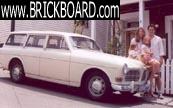|
Hello All:
1967 Volvo 122S Wagon. Another chapter of "Restoring Virginia," this time replacing the front engine mounts. Notice emphasis on the word FRONT. There is also a single rear engine mount but I have heard that you can only access it when you drop the transmission. Sadly, that day is coming soon and I will cover the third mount at that time but for now, I will focus on the front. Here are the vitals:
Tools Needed:
A hydraulic jack
2 jack stands
2 2x4 wood pieces, approximately 8 in. in length
2 standard bricks or wood blocks of similar dimensions
11/16" socket wrench (I also have a ratcheting "shorty" wrench which came in handy. "Nice-to-have" vs. must-have.
Supplies Needed:
2 engine mounts (I got mine from IPD, $6.40 each, part #666890)
PB Blaster or other unseizing agent
As you all know, so many jobs seem easy on the surface and end up being much more complicated. This is, thankfully, one of those jobs that is easier than you might guess. My only caveat is if you tend to work alone - as I do - work very slowly and methodically. Once you jack up the engine there is a lot of potential energy stored there and you must be careful. Let us get started:
First, jack up the car and put it on jack stands at the lowest setting. You are just trying to create a bit of clearance underneath to work since you will be accessing both the top and bottom nuts of the engine mounts from underneath.
Throw down some newspapers or cardboard, climb under the car and douse the nuts of the engine mounts (both top and bottom) with healthy doses of PB Blaster or other unseizing agent. Giving a few minutes for it to work its magic, position your jack under the front of the engine block. Place one of the 2x4 pieces on your jack, then carefully center the two bricks or wood blocks on top, placing the last 2x4 on top of this stack. Jack up your contraption to just under the engine block and JUST barely jack up the engine block to relieve pressure from the top nuts.
Now remove the top nuts and washers from both engine mounts. You will probably need the largest socket wrench you have for leverage in order to break the bond, particularly when you move on to the bottom nuts.
Once you have removed the top nuts, release the jack pressure and now remove the bottom nuts. Save your washers and nuts. The IPD mounts come with their own washers and nylon-insert nuts. By all means, use these new bits if provided.
Now comes the fun part and again, please be careful here. Position the jack under the front of the engine block so it is just slightly to the passenger-side of center. You want to jack up the engine block just enough so you can remove both of the old engine mounts as soon as the threads clear the holes. You will notice the lower holes are actually slots - these will enable you to "rotate" the mount out. Jack up just a bit at a time, keeping an eye on your blocks and the engine to ensure everyone is staying friendly.
In my case, the driver's side of the engine rose up quite a bit more than the passenger side so keep an eye out to ensure that you only go up as far as you must. Once you remove both old engine mounts, quickly but carefully insert your new engine mounts. Due to compression of the old mounts, you will probably find the new mounts need a bit more clearance. Jack up just a bit more if needed and WATCH THOSE FINGERS. Like I said earlier, there is a lot of potential energy stored in an engine block in the sky.
Now put the top nuts on the engine mounts and tighten down just enough so the mount is pulled up into the flange. This will help angle the lower mount studs toward the lower holes. Just leave a little wiggle room so you can guide the studs in as you lower the jack. Be very careful not to shake the engine as you do this lest you disturb the wood block support.
At this point you are ready to bring things home. Lower the jack just a bit at a time, guiding the lower studs through the slotted holes. Again in my case, the passenger side came home first, followed by the driver side. Sorry to be a noodge, but WATCH THOSE FINGERS.
Once you have successfully lowered the engine block all the way, put on your bottom nuts and tighten the top and bottom nuts securely.
Jack up the car, remove your jack stands, and hit the road.
Cheers,
Pooch
|

